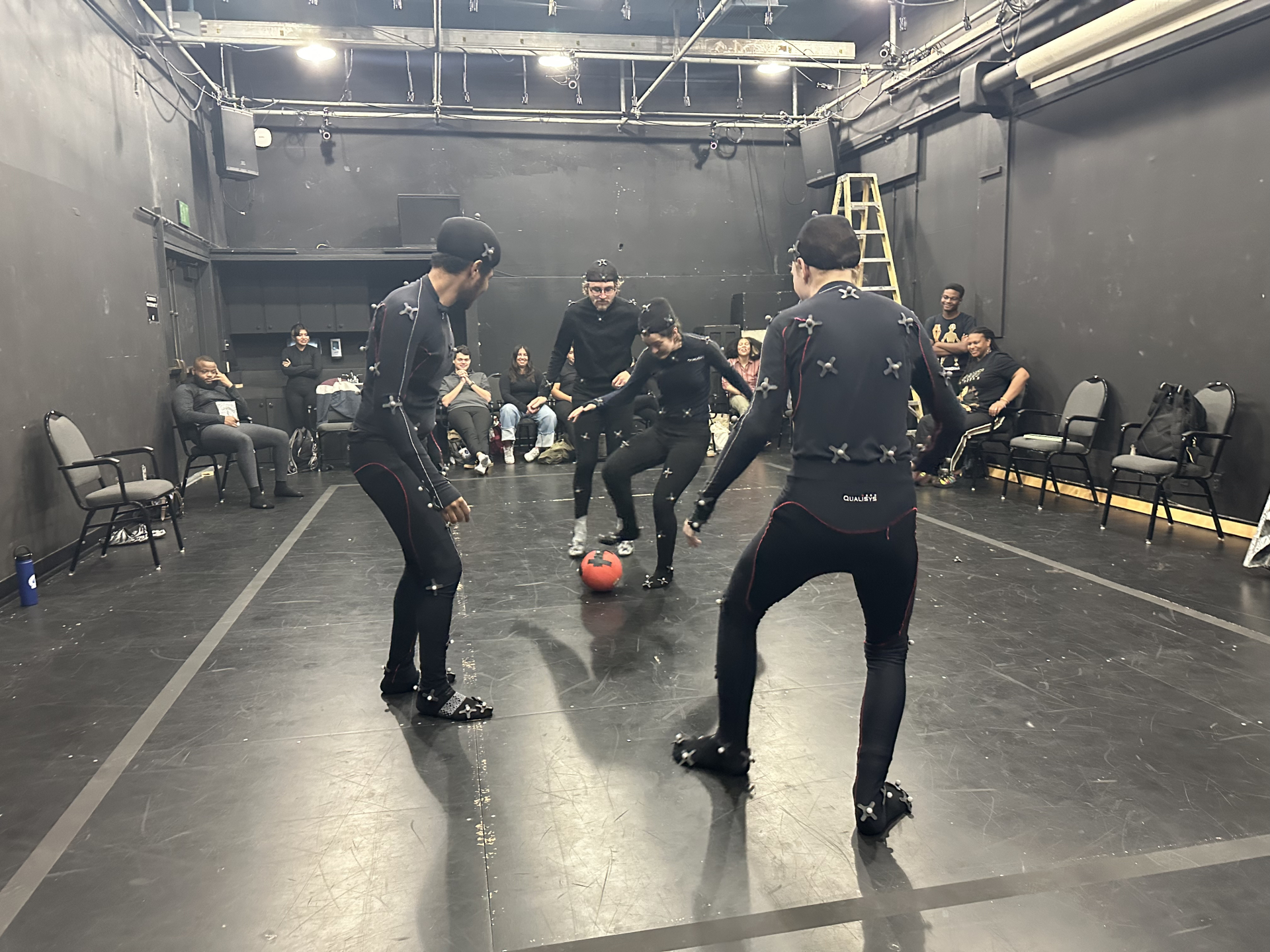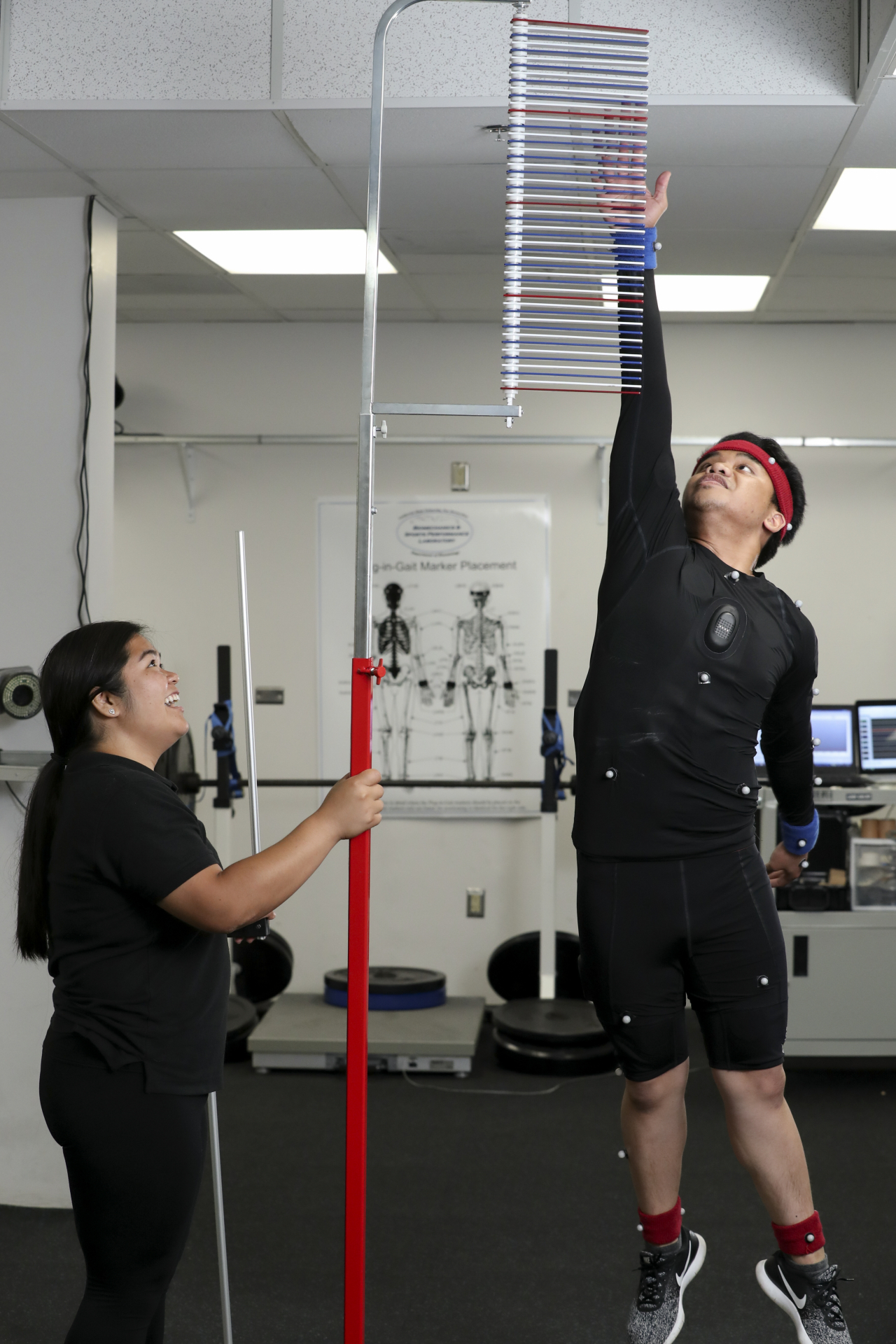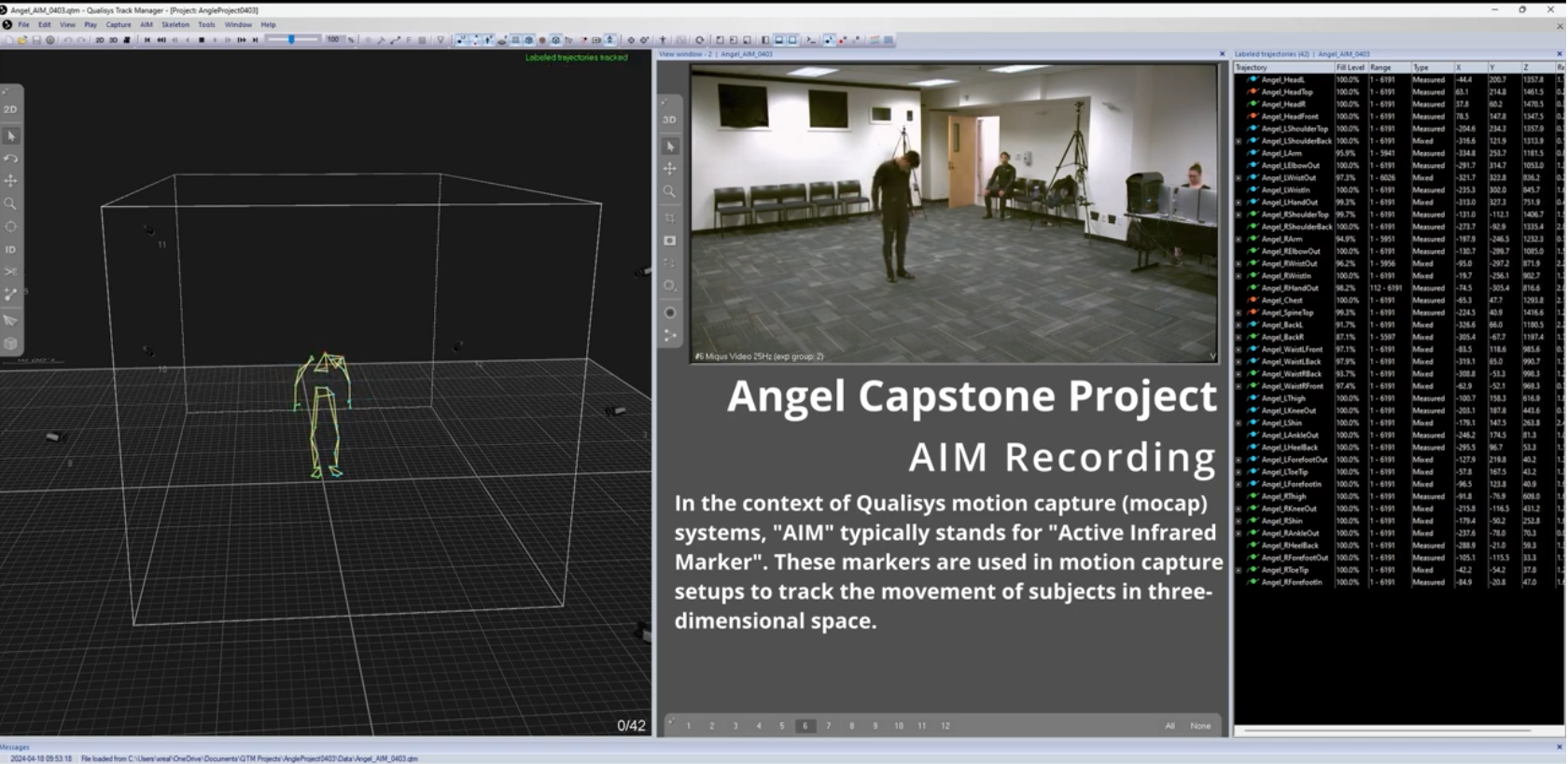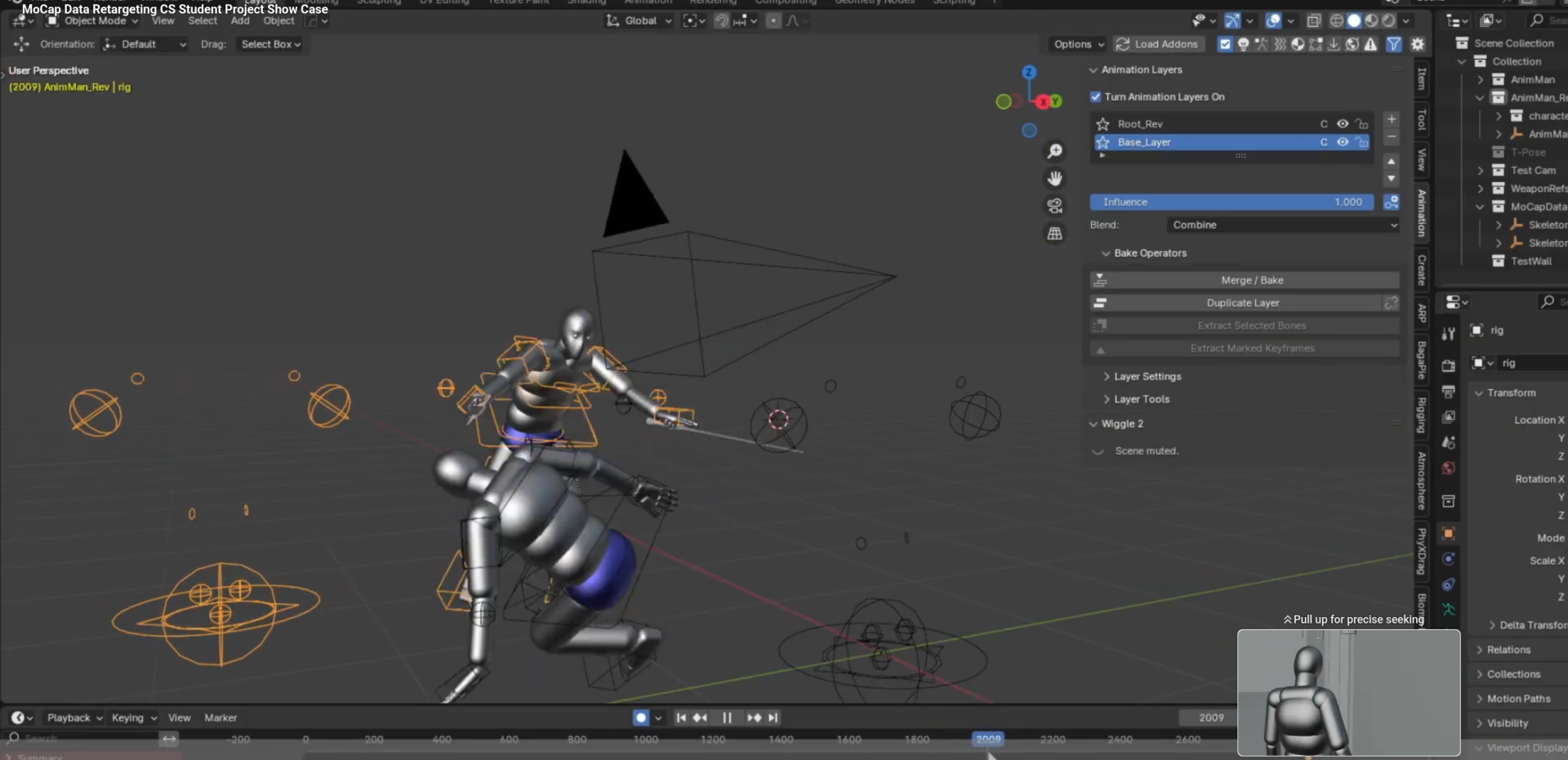The CSUSB Motion Capture Studio
The CSUSB Motion Capture Studio empowers innovation through the fusion of technology, art, and science. As a cross-disciplinary research and creative space, our mission is to advance learning, collaboration, and discovery by integrating motion capture into education, performance, and research, connecting students, faculty, and industry partners across the Inland Empire and beyond.
Motion Capture Technology
Motion capture (mocap) is an advanced technology that records and translates movement from people, or objects into digital data. At CSUSB, the Qualisys optical motion capture system enables precise tracking and analysis of full-body movement for animation, research, and interactive experiences.
How the Qualisys Motion Capture System Works:
1. Setup: Multiple infrared cameras are positioned around the capture area to record motion from every angle.
2. Markers: Reflective markers are placed on key points of the body or object being tracked.
3. Capture: Cameras detect the reflected infrared light and triangulate each marker’s position in 3D space.
4. Processing: The Qualisys Track Manager (QTM) software reconstructs and refines the motion data for animation, biomechanics, or performance analysis.




Cross-Disciplinary Research Hub
Established in 2021 as part of the xREAL Lab, the CSUSB Motion Capture Studio serves as a research and creative space for multiple colleges and disciplines across the university.
The studio supports projects and coursework in:
- Kinesiology: Studying human movement and biomechanics using real-time data.
- Theater Arts: Exploring performance, character movement, and digital acting for stage and virtual production.
- Visual Arts & Animation: Creating lifelike character animation and immersive digital art experiences.
- Computer Science: Uses motion capture data to develop interactive simulations, games, and AI-driven motion analysis tools.
This cross-disciplinary approach fosters collaboration, innovation, and applied research that connects technology, science, and the arts in one room.

Theater Arts Collaboration
The xREAL Lab has been pivotal in integrating motion capture into the Theater Arts Department. Under the leadership of Professor Kristi Papailler, the lab has developed innovative courses like "Acting for Motion Capture," where students learn to adapt traditional acting skills to digital environments.
One of the program’s standout achievements is the Halloween play Hauntenanny, directed by Professor Kristi Papailler. This performance was collaboratively created by Theater Arts students and the xREAL Lab team, showcasing how motion capture technology can enhance storytelling and live performance.

Applications in Kinesiology
The Motion Capture Studio also advances kinesiology research and teaching by providing real-time analysis of human motion. Students and faculty can study biomechanics, gait analysis, and physical performance in ways previously not possible. At the Palm Desert Campus, Dr. Warren Forbes utilizes similar technology to expand kinesiology instruction and research opportunities.


Game Development and Computer Science
Graduate students in the Computer Science Department have leveraged the motion capture studio to develop dynamic and immersive video games. By capturing realistic human movements, these projects push the boundaries of interactive design and technology, helping students build industry-relevant skills.
Expanding Opportunities with MIT
The Multimedia and Immersive Technology (MIT) Department, led by Professor Rafael Duffie, is actively working to expand access to motion capture technology for both students and faculty. This initiative ensures that more individuals can explore the transformative potential of this tool across disciplines.
MIT staff member Yutong Liu oversees the motion capture studio and is developing a series of workshops designed to introduce students and faculty to the fundamentals of motion capture. These workshops will provide hands-on training, enabling participants to effectively integrate motion capture into their projects.

A Hub for Interdisciplinary Innovation
The CSUSB Motion Capture Studio is more than a lab, it’s a collaborative research and creative environment where students and faculty from across disciplines explore the intersection of technology, movement, and storytelling. This dynamic space fosters experiential learning through hands-on development, giving faculty and students the opportunity to transform ideas into immersive, real-world applications.
By bringing together expertise from Theater Arts, Kinesiology, Computer Science, Visual Arts, and Music Technology, the studio encourages interdisciplinary exploration and innovation. Students learn by doing, whether they’re performing for digital characters, analyzing biomechanics data, designing interactive simulations, or creating virtual productions.
Through this integration of art, science, and technology, the Motion Capture Studio provides a unique platform for students to gain practical, industry-relevant experience while contributing to groundbreaking research and creative projects. As part of the xREAL Lab, the studio continues to push the boundaries of immersive media, preparing the next generation of innovators, creators, and researchers.
If you’re interested in learning more or exploring collaboration opportunities, please contact us or visit the xREAL Lab for a tour of the facility.
Performing Arts student project
This project originates from Professor Kristi Papailler’s student, Angel, who developed a creative concept to design and perform a combination piece as part of his capstone project. The performance explores the relationship between movement, storytelling, and digital embodiment, showcasing how traditional acting techniques can be transformed through motion capture technology.
The xREAL Lab is supporting Angel’s work by utilizing Unreal Engine 5’s free marketing simulation environment and integrating a MetaHuman character to deliver and demonstrate his performance in an immersive digital format. This collaboration bridges performance and technology, giving students hands-on experience in virtual production and digital character animation—an essential skill set in today’s entertainment and interactive media industries.

Computer Science Student Project Azrael
Our collaboration with Fantastic Games on Project Azrael has been an exciting and rewarding experience for the xREAL Lab Motion Capture Studio. Working closely with their development team has allowed us to help establish a streamlined workflow that transforms raw motion capture data into game-ready animations—bringing professional-level production capabilities to an emerging studio.
Through our sessions, we’ve captured a range of realistic character movements that have significantly enhanced the visual fidelity and immersion of Project Azrael. It’s been gratifying to see how efficiently the team integrates our processed data—typically delivered within a week—directly into their Unreal Engine pipeline. The resulting animations retain a high degree of accuracy and nuance, minimizing the need for additional cleanup or retargeting.
While capturing high-speed or large-scale movements occasionally presents tracking challenges, these moments have provided valuable insight into ways we can continue refining our capture setup. Expanding the capture volume and optimizing the Qualisys system parameters will further improve performance for more dynamic scenes.
Overall, the collaboration with Fantastic Games has been a model of creative and technical partnership. Their commitment to quality and storytelling aligns closely with our own, and we’re proud to contribute to the ongoing success of Project Azrael.
Motion Capture Service Team:
Yutong Liu
Motion Capture Studio Lead, Multimedia & Immersive Technologies (MIT)
Yutong Liu oversees operations and research development in the CSUSB Motion Capture Studio. With expertise in immersive technology integration and digital media production, Yutong leads workshops and collaborative projects that introduce students and faculty to motion capture applications across disciplines. Her work focuses on bridging technology with creative practice, helping shape CSUSB’s reputation as a leader in immersive learning and motion-based research.
Bobby Laudeman
Programmer, Multimedia & Immersive Technologies (MIT)
Bobby Laudeman manages production coordination and interdisciplinary collaboration within the MIT department, supporting projects that combine motion capture, virtual production, and live media. His background in computer programming and creative talents drives the development of high-impact initiatives that showcase CSUSB’s capabilities in immersive storytelling and motion capture innovation.
Professor Kristi Papailler
Department of Theatre Arts
Professor Kristi Papailler holds an MFA in Performance and Graduate Certificate in African American Theatre from the University of Louisville. At CSUSB (Department of Theatre Arts), they serve as the Head of Acting, Department Advisor and a Returning Faculty Fellow in the XReal Lab. Current research includes her lab "Motion Capture and the Future of Education" and "the Blackbox of The Future in collaboration with the XReal Lab, Academic Technologies, Theatre and Music Departments and funded through the generous support of VETI grants. In addition to teaching, research and creative scholarship at CSUSB Professor Papailler maintains a prolific schedule of contributions to the field through professional performance and directing roles throughout the US.
Assistant Professor Martim S. Galvão
Music Technology
Professor Martim S. Galvão is a faculty fellow with the xREAL Lab. A Brazilian-American composer and multimedia artist, his work bridges music production, immersive audio, and interactive media. Martim integrates technology and performance through projects involving spatial sound, electronic composition, and motion capture, helping expand CSUSB’s cross-disciplinary research in music, art, and digital media innovation.

